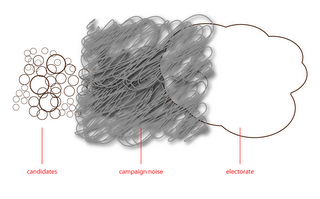design of democracy (6)
signal, noise and oligopsonies
   | At last. This took a while. I struggled with parsing the design ideas but realized that I needed to talk about the system in more theoretical terms (i.e. -signal processing and economics). I struggled with making the concept as succinct and reachable as possible but decided I didn't want to sound condescending nor do I want to patronize my readers (assuming I still have readers). I hope you take this (more esoteric) post in the context of the rest of the series (1, 2, 3, 4 and 5). In my last post on this topic, I discussed how large electorates basically cause a market failure in the eoconomic-transaction model of democratic elections. The information asymmetry inherent in reaching a large electorate causes a market failure by reversing the transactional role of the candidate and the voter. The candidate becomes the buyer in the equation, the voter is the supplier. The kink in the system is that the buyer buys only in bulk -and the power shifts to the aggregators (middlemen) who can deliver or assemble the required number of votes. (The role of the aggregator can take the relatively "benign" form of the spinmeisters and message shapers or the media. It can also take the more malignant incarnation of the dagdag-bawas comelec mafias.) The small number of bulk buyers (candidates) relative to the large number of suppliers (voters) characterizes an oligopsony. |
The information asymmetry in the system is basically a signal vs. noise problem. The large electorate prevents direct one-to-one communication (symmetrical communication) between candidate and voter. To reach as large an audience as possible (to sway as many voters), the candidate's message must be amplified through various channels. Inherent in any amplification is distortion, noise and filtering. The fidelity of the signal is further compromised by the adversarial nature of elections. Attack ads, dis- and mis- information campaigns increase the noise in the system apart from the cacophony of multiple messages from multiple sources. Again, both the candidate and the voter (moreso the voter) cede power and control of the communication (and subsequent transaction) to the media channels.
(Some may argue that new media (the internet) may correct some of that information asymmetry. The Net does undercut the role of traditional media but current technology only really adds to the noise, requiring even more work for the voter to extract signal from noise.)
How we solve the problem? Well, how does one solve a) oligopsonies and how does one b) reduce noise in the system?
oligopsonies
- You can try to regulate an oligopsony so as to cut the power of the buyers and aggregators.
- Or you can act break up the market. In an oligopsony, the suppliers (voters) have less power because very large majorities (or pluralities) are required to win elections. (Each vote is further diluted by the number of posts a voter must fill up on the ballot.) Breaking the market almost always means atomizing the market. Breaking it up into smaller pieces so there are smaller markets with less candidates vying for the vote of a smaller electorates. (And no, this is not an argument for federalism. I am talking about the size of the markets, not the form of the governance.)
signal-to-noise
- You can reduce the noise in the system by increasing the signal and reducing the noise in the signal-to-noise ratio. You can try to do that by brute (technical) force by designing a system that checks for fidelity and corrects for deviations from the signal at multiple points. Systems that do this require more energy and more complexity. (The more complex a system, the higher the potential for failure.) Also, the stronger the amplification (i.e. -media to reach 50M voters) the more energy you need to ensure the fidelity of the signal.
- You can also spend energy to make a more sophisticated receptor that can internally filter noise from the signal.
- Or, you can cut the distance between the signal emitter and the receptor, reducing the need for amplification and lowering the incidence of noise.
What we haven't tried to do is option 2 in both cases: breaking up the market and cutting the distance between the emitter and receptor.
And this is where I make the case for smaller electorates - and ultimately the design proposal. That's up next in what is hopefully the last installment of this series.

2 comments:
Good Morning, Urbano
All I can say is, "Wow!!!"
Well, not really ALL because I want to explain my reaction.
Your approach never occurred to me. Yet, if it's not presumptuous for me to say so, we reached similar conclusions. Your description, though, adds flesh to mine.
* "The candidate becomes the buyer in the equation, the voter is the supplier. The kink in the system is that the buyer buys only in bulk -and the power shifts to the aggregators (middlemen) who can deliver or assemble the required number of votes."
To me, the parties are the aggregators. You show that is possibly, but not necessarily, so.
* "... both the candidate and the voter (moreso the voter) cede power and control of the communication (and subsequent transaction) to the media channels."
This important idea accomplishes something I was unable to do. I've been vociferous in denying that "the people" are stupid, but I've struggled to explain why the electorate votes as it does. You provided the explanation in succinct terms.
These two points help show why one need not use a value-based (or judgmental) approach to understanding socio-political problems.
Ohhhhh! And to inspire a smile, I've never heard of an "oligopsony". For crying out loud, my 1965 edition of Encyclopedia Brittanica doesn't even have an entry for it.
Fred
Fred,
I am flattered.
Yes, we did reach similar conclusions. I hope my ideas are cross-validated by your many years of wisdom.
Hopefully, we can get others to listen.
-udc
Post a Comment